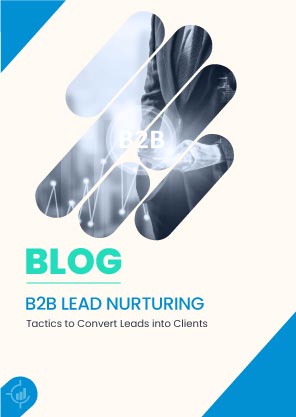or call: +1 (845) 347-8894

or call: +1 (845) 347-8894
or call: +1 (845) 347-8894

In B2B marketing, getting a lead is just the start. The real challenge is helping that lead grow into a client. This journey isn’t rushed. It’s built on trust, value, and helpful steps along the way. This ongoing process is what we call B2B lead nurturing.
Think of it like gardening. You plant a seed (the lead), and then water it with useful info, light it up with personal touches, and keep the weeds of doubt away. Over time, that seed grows into a solid customer relationship.
Great lead nurturing keeps your brand at the top of your mind. It answers questions, solves problems, and gives the buyer a reason to stay connected. And when the timing feels right, that lead turns into a client. Not because of pressure, but because of trust.
In this guide, we’ll explore how to do that well. No jargon, no fluff, no confusion. Just simple, clear strategies that help real people make smart choices.
B2B lead nurturing is all about guiding potential clients through their decision journey. It’s not about hard selling. It’s about giving value at the right moment, through the right channel.
Unlike in B2C, where a shopper might buy on impulse, B2B buyers take their time. There are usually multiple people involved, lots of questions, and a long decision path. That’s why nurturing is so essential. It bridges the gap between “just looking” and “let’s do this.”
Here’s what good nurturing includes:
Imagine you’re buying software for your team. You don’t want five sales calls. You want someone to help you understand how it works, how others use it, and whether it’s worth the money. That’s what nurturing does.
With the right approach, you become more than a product. You become a helpful partner. That’s when the magic happens. You stop chasing leads and start building real relationships that lead to real deals.
B2B sales cycles are often long and involve multiple decision-makers. Your leads are likely comparing options, discussing internally, and analyzing risks. If you go silent after the first interaction, you’ll be forgotten.
Here’s why nurturing matters:
According to industry insights, companies that excel at lead nurturing generate 50% more sales-ready leads at a 33% lower cost.
Let’s dive into practical, easy-to-apply lead-nurturing tactics.
Your leads are in different stages of decision-making. Some are just discovering a problem, while others are evaluating vendors. Provide content that fits their stage:
By meeting leads where they are, you help them move forward without pressure.
Email remains one of the most powerful tools in B2B nurturing. But blasting the same message to everyone doesn’t work.
Tips for effective email nurturing:
A drip campaign that gradually shares insights is better than one big sales pitch.
Intent data shows what topics or solutions your potential customers are actively exploring on the internet. It shows buying signals you might otherwise miss.
When a lead starts searching for “best CRM tools for small businesses,” that’s your cue to share relevant content or offer a demo.
Platforms like Bombora and ZoomInfo can help you gather this data and act on it before your competitors do.
Email alone is not enough. Engage leads across different channels for better visibility and impact.
Each touchpoint adds value and keeps your brand relevant.
Not all leads are ready for a sales call. Lead scoring helps you rank prospects based on their engagement and readiness.
Assign points for actions like:
Higher scores signal higher interest. This lets your sales team focus where it matters most.
Marketing generates leads, but sales closes the deals. If they aren’t aligned, leads fall through the cracks.
How to build alignment:
When both teams collaborate, conversion rates improve significantly.
Nurturing doesn’t stop when someone becomes a client. Keep delivering meaningful value to maintain their interest and strengthen their loyalty.
Happy clients often turn into brand advocates.
To know if your lead nurturing is working, track these key performance indicators:
Review these metrics regularly to refine your approach.
Even with the best tools, things can go wrong. Watch out for these common missteps:
Fixing these issues can make a big difference.
Forget tired scripts and old tricks. The new age of B2B nurturing is full of life. Buyers today are sharp. Tools are better. And the old ways? They’re fading fast. To lead in this space, you must tune in to what matters.
Let’s explore what the future holds:
AI as Your Guide: Think of AI like a smart friend. It watches where leads click, what they pause on, and what they ask. Then, it helps you reply with care. No more cold blasts. Just warm, well-timed notes that feel made for them.
Content That Moves Old-style guides are out. Now, leads want tools they can touch. Quizzes that show gaps. Polls that ask for views. ROI tools that make costs clear. These help you learn more about your leads while keeping them engaged.
ABM: Less Push, More Focus Account-based marketing flips the old way. You don’t wait; you build smart plans for the right accounts. Think custom pages, tailored stories, and focused chats. You talk to them, not at them.
Real Talk, Real Time Leads don’t want to wait. With live chat or bots, they can ask and get help fast. No forms. No hold times. Just clean, quick replies. It makes your brand feel human in a digital space.
These aren’t just trends. There are shifts in how we talk, share, and build trust. The best brands won’t just follow. They’ll lead with care and real value.
Because not all leads are ready to buy. Some need to learn, others need proof. Matching your message to their stage keeps them engaged.
Short blogs, infographics, and quick videos. Keep it helpful and easy to understand.
Check how they interact. A lead downloading a whitepaper is likely exploring. One asking for pricing may be ready to commit.
Sometimes, yes. A well-made video or guide can spark interest and still give depth. But more focused content works better.
Start small. Repurpose what you already have. Turn a blog into a checklist or a case study into a short slide deck.
To participate in our interviews, please write to our IntentTech Media Room at sudipto@intentamplify.com
